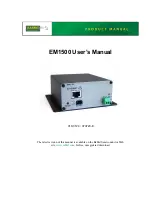
Compu Pool Infinity Series Manual AU
7
5.4.3
Increase chlorine production when bather loads increase.
5.4.4
Use Stabiliser (Cyanuric Acid) to protect free chlorine in pool
5.4.5
Decrease chlorine production when temperature goes down.
5.4.6
Take pool water sample to a Pool Professional once per month.
5.5
Not Recommended List
5.5.1
Do not allow fertilizer anywhere near your pool. Fertilizers contain Nitrates or
Phosphates which cause severe chlorine demand in pool water.
5.5.2
Never use dry acid to adjust pH. A build up of by-products can damage the
Electrolytic Cell.
5.5.3
Do not add any pool water balancing chemicals (including salt) unless the Power
Unit is turned off.
5.5.4
Do not add any chemicals (including salt) to the skimmers.
5.5.5
Do not let salinity level drop below 3000 ppm.
5.6
Definitions
5.6.1
Algae.
Plant-like organisms which grow in water. Especially active in summer
conditions, where chlorine disinfectant levels are too low to destroy them. Algae
may be green, yellow, brown or black (Black Spot) in colour.
5.6.2
Chlorine Demand.
The amount of chlorine that should be added to the water to
provide proper bacteria and algae control.
5.6.3
Chlorine Residual.
The amount of chlorine left over, after the “demand” has been
met.
5.6.4
Combined Chlorine.
Weak chlorine which is combined with the contaminants in
the water.
5.6.5
Free Chlorine.
Active chlorine in the water with the potency to destroy
contaminants.
5.6.6
Shock Treatment.
The removal by means of oxidation of those materials that have
chlorine demand.








































